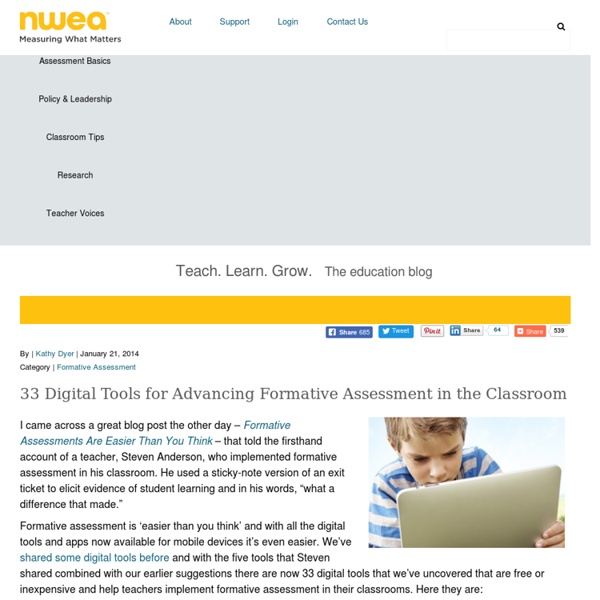A Comprehensive Framework For Student Motivation
A Comprehensive Framework For Student Motivation by Terry Heick When researching student motivation and gamification late last year, I came across the most comprehensive gamification framework I’ve ever seen. Developed by gamification expert Yu-kai Chou, it was an ambitious effort that distinguished black hat gamification (which is “bad”–think Farmville and Candy Crush) from white hat gamification (which is “good”–think Minecraft or even an ACT score). (It’s also copyrighted, but they graciously allowed us to use it.)
The Best 8 Web Tools for Doing Formative Assessment in Class
February 25, 2015 Formative assessment, as we have agreed elsewhere, is assessment for learning which is completely different from summative assessment, which is assessment of learning. The insights gained from formative assessments are usually used to decide on the next instructional steps and also inform teachers as to the additional opportunities needed to ensure students' success. Examples of formative assessment include: assigning projects and performances, giving writing assignments, and asking questions.
Free and best way to Check Duplicate Content ~ MY SEO PRANK
After the updation of Google Panda Algorithm in 24 Feb 2011 the basic scenario of panda algorithm is to unique content is the first priority of any website and the second one is if any website have broken link then it could be penalized by Panda Algorithm. And you could drop your ranking. So After Panda Algorithm you can't use duplicate content in your website.
Formative Assessment: Bridging the Research - Practice Divide
“Teach, mark, move on: that’s the old paradigm. Today’s classrooms have changed. It is important to show the students where they are, how to improve, and where to go from here… It’s no longer about “this is your mark and that’s the end of the story”.
Yes, You Can Teach and Assess Creativity!
A recent blog by Grant Wiggins affirmed what I have long believed about creativity: it is a 21st-century skill we can teach and assess. Creativity fosters deeper learning, builds confidence and creates a student ready for college and career. However, many teachers don't know how to implement the teaching and assessment of creativity in their classrooms. While we may have the tools to teach and assess content, creativity is another matter, especially if we want to be intentional about teaching it as a 21st-century skill.
Seven Tech Tools for Fast Formative Assessment
by Curtis Chandler You and I would be hard-pressed to find a teacher who’s against formative assessment. We would have better luck finding someone who hates whales or pizza. In theory, every teacher is regularly designing and deploying a variety of outcomes-based learning activities that help the teacher determine where students are in the learning process.
10 best practices for successful project management
The right mix of planning, monitoring, and controlling can make the difference in completing a project on time, on budget, and with high quality results. These guidelines will help you plan the work and work the plan. The right mix of planning, monitoring, and controlling can make the difference in completing a project on time, on budget, and with high quality results.
75 Digital Tools and Apps Teachers Can Use to Support Formative Assessment in the Classroom
There is no shortage of formative assessment strategies, techniques, and tools available to teachers who use formative instructional practice in their classrooms. Here is an extensive list of 75 digital tools, apps, and platforms that can help you and your students use formative assessment to elicit evidence of learning. We didn’t just add any old tool to this list.
Plickers 2.0
An Easy to Use Student Response System Why Should You Use Plickers? Plickers is a FREE app that can be used on any IOS or Android operating system developed by Nolan Amy.
The Montessori Method: An Education For Creating Innovators
Imagine an education system that trained students to be creative innovators and leaders without the use of grades, tests or homework. It actually exists and it’s called the Montessori Method. The Montessori Method focuses on fostering a hands-on, self-paced, collaborative and enjoyable learning experience. It teaches students to start small with their ideas, to build them through experimentation and to solve the problems that come up along the way with a sense of stimulating curiosity.
20 useful ways to use TodaysMeet in schools
TodaysMeet is an easy-to-use, versatile digital tool. It can enhance discussions, provide a place for ideas and more. TodaysMeet is so simple yet so versatile that it has become one of my go-to digital tools. It’s designed as a backchannel — the conversation behind what’s going on. TodaysMeet creates personal chat room that you can set up and invite people to. They can quickly and easily write comments or questions for anyone in the chat room to see.
Bluejacking
This Siemens M75 is Bluejacking the Sony Ericsson K600i pictured below This Sony Ericsson K600i is getting Bluejacked by the Siemens M75 pictured above. The text at the bottom of the screen reads "Add to contacts?"
5 Critical Steps to Doing Formative Assessments - Illuminate Education
Formative assessments can make a big difference in the classroom. The evidence proves it. Many studies show that the average effect size of the impact of formative assessment on standardized tests is 0.4 to 0.7. The change in “effect size” is considered as going from moderate to strong. That’s a home run in the world of treatment effects.
Socrative - Chromebook Classroom
Socrative is a student response system. Instead of students using clickers to answer questions, they use their Chromebooks (or any web enabled device). Socrative can be used for bell ringers, quizzes, checks for understanding or exit tickets. Socrative recently released Socrative Snow.



